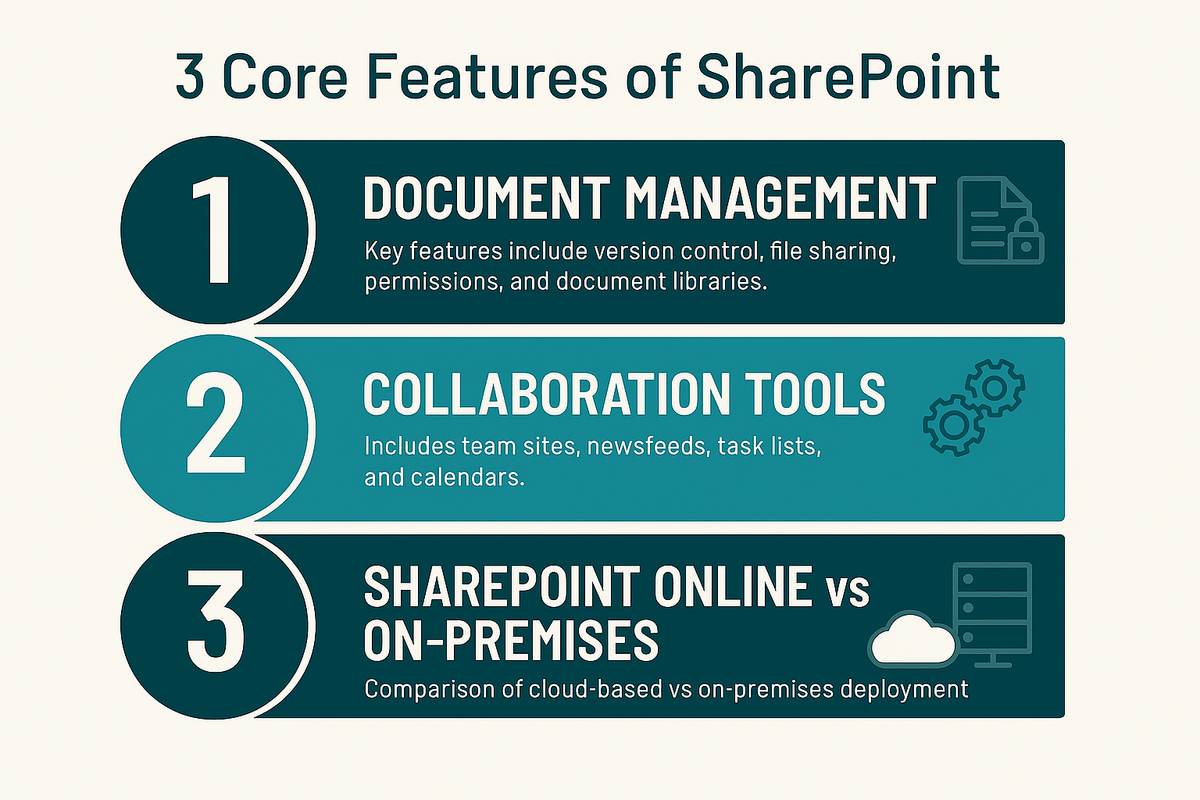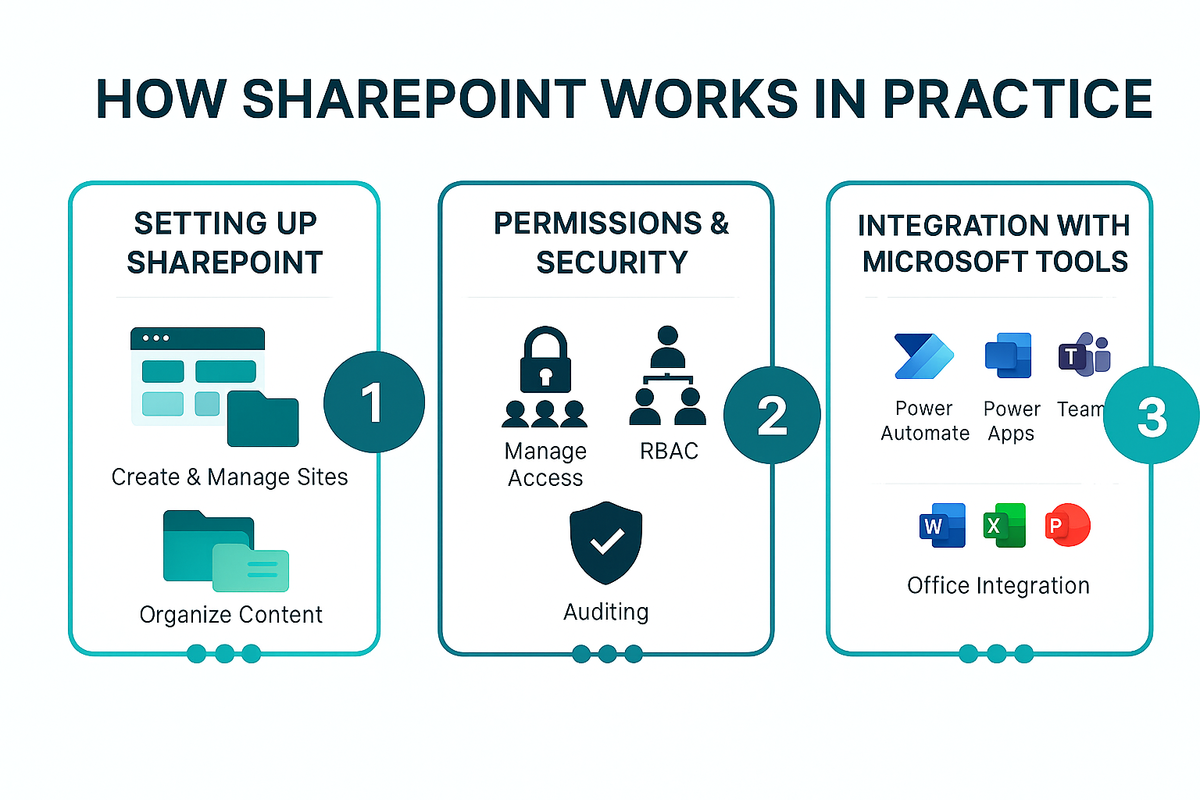Are you wondering how does SharePoint work? SharePoint is a tool that helps businesses manage content and work together. It lets teams store, share, and organize documents securely and easily. SharePoint features like document management and collaboration make it essential for businesses.
What is SharePoint used for? It helps teams work better together, manage documents, and improve business processes. What is SharePoint used for? It simplifies keeping information in one place, integrates with other tools, and automates tasks. It’s a popular solution for businesses of all sizes because it helps manage projects and documents efficiently.
With SharePoint online intranet solutions, it makes it easy to keep information in one place, connect with other tools, and automate tasks. It’s a popular solution for businesses of all sizes because it helps manage projects and documents efficiently.
In this guide, we will explain SharePoint’s core features, how it works, and how businesses can use it. We will also share tips and best practices to help you get the most out of SharePoint.
What is SharePoint?
SharePoint is a web-based platform. It is designed to help teams collaborate and manage content. What is Microsoft SharePoint? It is mainly used for document management, offering tools to streamline team collaboration, manage files, and improve productivity. SharePoint also supports file sharing, ensuring easy access and organization of business documents.
SharePoint is mainly used for document management. It also supports file sharing and team collaboration, offering SharePoint document & content management services to help businesses store, manage, and organize their documents efficiently.
SharePoint collaboration tools enable teams to communicate in real-time. Teams can share documents and work together on projects from anywhere. Through SharePoint site creation, businesses can build dedicated spaces. These spaces can be for teams, departments, or projects.
SharePoint workflow automation streamlines business processes. It automates repetitive tasks such as approvals and notifications.
A Brief History of SharePoint
SharePoint started as a document management tool in the early 2000s. It has evolved into a powerful platform. It now supports collaboration, content management, and business automation. Over time, SharePoint strategy & planning services have been integrated to help businesses better understand how to align SharePoint with their long-term goals and needs.
The shift to SharePoint Online brought cloud-based features. This enabled companies to access SharePoint from anywhere. Companies could access it anytime. Major milestones include the launch of SharePoint Server.
The introduction of SharePoint Online with Office 365 followed. There has been continuous integration of new features. These include automation tools and collaboration features. Over time, SharePoint has become a central hub for document sharing. It also serves as a key tool for team collaboration in businesses worldwide.
Explore Our SharePoint Consulting Services!
3 Core Features of SharePoint
SharePoint offers a wide range of features to help businesses. These features support efficient workflows and make sharing information easier. Following are some of the core features of SharePoint.

1. Document Management
SharePoint document management allows teams to store and manage documents securely. Key features include:
- Version control: Track changes made to documents. Easily revert to earlier versions.
- File sharing and permissions: Share documents with colleagues. Set permissions to control access.
- Document libraries: Organize and store documents in an easy-to-navigate structure. Libraries make it simple to find and manage files.
Explore Our SharePoint Document & Content Management Services!
2. Collaboration Tools
SharePoint is designed to enhance teamwork. It provides tools that help teams work together seamlessly:
- Team sites: Create spaces for teams to store documents and collaborate on projects.
- Newsfeed and discussions: Keep everyone updated with team newsfeeds and discussions.
- Task lists and calendars: Manage tasks and deadlines with integrated task lists and shared calendars.
3. SharePoint Online vs On-Premises
When choosing between SharePoint Online and On-Premises, businesses must consider their needs for flexibility, control, and security:
- Benefits of cloud-based SharePoint: SharePoint Online offers easy access from anywhere. It reduces the need for on-site infrastructure.
- Key differences: On-premises versions offer more control over data and customization. However, they require dedicated IT resources. Cloud-based SharePoint minimizes infrastructure management but offers less direct control.
Explore Our SharePoint On-Premises Intranet Solutions!
How SharePoint Works in Practice?
SharePoint is designed to be an intuitive platform for managing content and collaboration. It offers an easy-to-use interface for organizing, securing, and setting up business information.

From creating sites to managing permissions, SharePoint provides the tools to boost team productivity. This section explores how SharePoint works in practice and integrates with other Microsoft tools.
1. Setting Up SharePoint for Your Organization
Setting up SharePoint is simple and flexible:
How to create and manage sites?
Create sites for teams, departments, or projects. Customize each site with document libraries, task lists, and web parts to fit your needs.
Best practices for organizing content
Organize documents with clear folder structures and metadata. Using content types simplifies management and speeds up access to information.
2. SharePoint Permissions and Security
Managing user access is key to protecting business data:
How to manage user access?
Control who can access sites or documents by assigning permissions. Admins can customize access based on roles and responsibilities.
Role-based access control (RBAC)
RBAC assigns permissions based on a user's role. This ensures employees only access the info they need for their job.
Auditing and compliance features
SharePoint tracks user activity and ensures compliance with regulations, maintaining data security and meeting standards.
3. Integration with Other Microsoft Tools
SharePoint integrates seamlessly with Microsoft apps to boost productivity:
Power Automate, Power Apps, and Microsoft Teams integration
Use Power Automate for workflow automation. Power Apps lets you create custom business apps. Teams integration enables communication and file sharing within SharePoint sites.
Integration with Microsoft Office apps
SharePoint works with Office apps like Word, Excel, and PowerPoint. Users can collaborate in real-time, making edits, sharing, and managing documents directly within SharePoint.
SharePoint Customization and Extensibility
SharePoint provides powerful tools for customization and extensibility. Whether you need SharePoint customization services for site personalization or to integrate third-party applications, SharePoint offers the flexibility to meet your specific business needs. These features enable businesses to create a solution that fits their unique needs.
Whether you need SharePoint for team collaboration or enhanced SharePoint file sharing, customization plays a key role in making SharePoint work for your organization. Let’s look at how you can extend SharePoint to meet your specific requirements.
Customizing SharePoint Sites
Customizing SharePoint sites allows you to create the perfect environment for your team:
1. Modifying site templates
Start with a template that suits your needs and modify it to create a custom site layout. You can change the design and structure to fit your team’s workflow.
2. Adding web parts and custom pages
Add web parts such as calendars, lists, and document libraries to your site. Custom pages can also be created to display specific information tailored to your team.
Explore Our SharePoint Development & Customization Services!
Extending SharePoint with Apps and Web Parts
Extend the functionality of SharePoint by integrating apps and custom web parts:
1. Use of third-party apps
Integrate third-party apps to add extra features to your SharePoint site. Many apps are available in the SharePoint App Store that can enhance functionality such as CRM tools or project management apps.
2. Custom web parts and app development
For unique needs, develop custom web parts. This allows you to display information or interact with users in a way that fits your business requirements.
SharePoint Workflows and Automation
SharePoint workflows help automate business processes, saving time and reducing errors. With SharePoint migration & integration services, businesses can ensure smooth transitions as they integrate workflows into existing systems, making it easier to automate tasks such as document approvals and status updates.
1. Overview of workflows in SharePoint
Workflows automate tasks such as document approvals, status updates, and notifications. Workflows can be customized to meet your business requirements.
2. Automating business processes with Power Automate
Power Automate integrates with SharePoint to automate repetitive tasks. This helps businesses improve efficiency by automating tasks such as document management, approvals, and data collection. With SharePoint advanced features & innovation services, companies can explore even more sophisticated automation options to optimize their business processes.
SharePoint for Different Use Cases
How does SharePoint work? SharePoint is a flexible platform that can be used by businesses of all sizes. From SharePoint on-premise intranet services for on-site solutions to cloud-based SharePoint Online for seamless access anywhere, the platform supports various use cases, making it an ideal choice for both small businesses and large enterprises.
With its powerful features like SharePoint search capabilities and SharePoint customization options, it helps improve business productivity and collaboration. Let’s explore how SharePoint can be used in various business settings.
1. SharePoint for Small Businesses
SharePoint for business productivity is essential for small businesses that need to collaborate and manage documents securely. Here’s how small businesses benefit:
Small businesses can use SharePoint to store documents, track projects, and share files with ease.
The ability to customize sites and workflows helps small businesses create solutions that fit their unique needs.
2. SharePoint for Large Enterprises
SharePoint provides powerful features that are essential for large enterprises:
- Enterprise-level features: SharePoint supports scalability, security, and seamless integration with other enterprise systems. This ensures that large businesses can manage vast amounts of data securely.
- SharePoint security and compliance: Enterprises can use SharePoint to meet their security requirements. It offers compliance tools that ensure data is managed according to legal and regulatory standards.
3. SharePoint for Remote Teams
SharePoint is crucial for remote and distributed teams:
- Importance of SharePoint for virtual and distributed teams: SharePoint enables remote teams to collaborate effectively regardless of location. They can access documents, share updates, and work together on projects in real-time.
- SharePoint’s role in document collaboration and task management for remote workers: With SharePoint, remote workers can track tasks, update project statuses, and collaborate on documents, making it easier to stay productive.
Explore Our SharePoint Advanced Features & Innovation Services!
3 Common Challenges and Solutions with SharePoint
While SharePoint is a powerful platform, businesses often face challenges when implementing it. Understanding these challenges and knowing how to overcome them is key to success.
Common SharePoint Challenges
Fortunately, SharePoint support & optimization services can help businesses troubleshoot and resolve these challenges, ensuring the platform runs smoothly and integrates effectively with external systems. Some common challenges businesses face with SharePoint include:
1. Issues with adoption, training, and user resistance
Employees may resist using new tools. Training is essential to ensure successful adoption.
2. Managing large amounts of data
As businesses grow, managing increasing amounts of data in SharePoint can become difficult. Proper organization and optimization are needed.
3. Integration challenges with non-Microsoft systems
While SharePoint integrates well with Microsoft products, integrating it with non-Microsoft systems can be challenging.
How to Overcome SharePoint Challenges?
Here’s how businesses can overcome the common challenges with SharePoint:
1. Tips for successful SharePoint adoption
Focus on training and creating awareness about SharePoint’s benefits. Ensure that key stakeholders understand the platform’s value.
2. Training and support strategies
Provide ongoing training and support. Make sure employees are familiar with SharePoint customization options and how to use the platform effectively.
3. Best practices for data management and integration
Organize data with clear metadata and content types. Use best practices for data governance and ensure smooth integration with other systems.
Top 3 Best Practices for Using SharePoint
SharePoint is a powerful tool for managing content and collaborating across teams. To get the most out of SharePoint, it’s important to follow best practices for organization, security, and maintenance.
These practices will help ensure efficient SharePoint content management and make the platform more effective for your team.
1. Organizing SharePoint for Optimal Use
Efficient organization is key to a successful SharePoint experience:
- Folder structures vs metadata: Use metadata to categorize content rather than relying solely on folders. This makes it easier to search and retrieve documents.
- Use of content types and document libraries: SharePoint content management can be streamlined by using content types and document libraries. This ensures consistency across documents and makes management easier.
2. Security Best Practices
Keeping SharePoint secure is crucial for protecting business data:
- Setting up permissions and access control: Assign user permissions based on roles. This ensures that employees only have access to the documents they need.
- Regularly reviewing security settings: Review and update security settings regularly to keep up with changes in the organization and ensure that data is secure.
3. Maintenance and Updates
Regular maintenance helps keep SharePoint running smoothly:
- Keeping SharePoint up to date: Ensure that SharePoint features are regularly updated. This includes security patches and new features that enhance functionality.
- Regular backups and site health checks: Perform regular backups to prevent data loss. Conduct health checks to ensure your SharePoint site is functioning as expected.
FAQs: How Does SharePoint Work?
What Is SharePoint Used For?
SharePoint is used for document management and collaboration. It allows teams to store, share, and organize files securely. It also helps automate workflows, manage content, and integrate with Microsoft tools like Teams and Office 365 for seamless collaboration.
How Do I Manage Permissions in SharePoint?
Managing permissions in SharePoint is easy. You can assign access levels to users based on roles. SharePoint allows fine-grained control over who can view, edit, or delete content. Permissions can be set at the site, library, or document level.
What Is SharePoint Online?
SharePoint Online is the cloud-based version of SharePoint. It allows businesses to store, manage, and collaborate on documents in the cloud. It integrates with Office 365 for seamless file sharing and offers flexibility for remote teams and secure access from anywhere.
How Can SharePoint Improve Team Collaboration?
SharePoint improves team collaboration by offering centralized document storage, shared calendars, and team sites. It enables real-time editing, discussion boards, and task management. SharePoint ensures that team members can work together efficiently from anywhere, making collaboration seamless and productive.
Conclusion
SharePoint is a versatile platform that enhances collaboration and content management within organizations. How does SharePoint work? It simplifies document storage, sharing, and team communication. With features like automated workflows, permission management, and seamless integration with Microsoft tools, it helps businesses stay organized and efficient. For companies looking to optimize their digital workplace, partnering with Centric can elevate SharePoint’s potential by tailoring it to specific business needs.
Whether you’re working with a small team or a large enterprise, SharePoint offers scalable solutions. By using SharePoint, businesses can improve productivity, maintain security, and streamline operations.
The platform’s flexibility makes it ideal for various use cases, from managing files to automating processes. To get the most out of SharePoint, it’s essential to follow best practices for setup, security, and customization. With the right approach, SharePoint can transform how your team collaborates and manages content.









